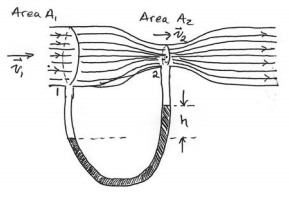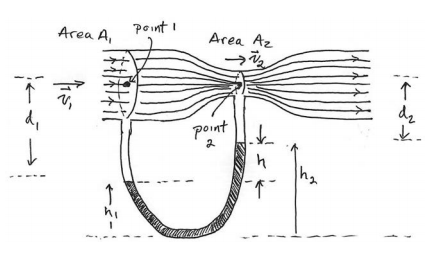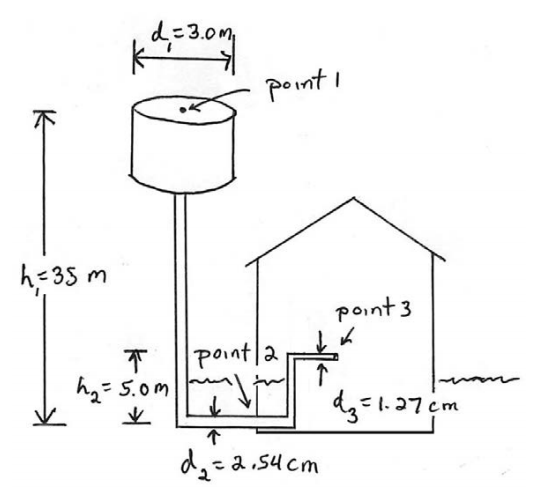28.5: Worked Examples- Bernoulli’s Equation
( \newcommand{\kernel}{\mathrm{null}\,}\)
Example 28.5.1: Venturi Meter
Figure 28.8 shows a Venturi Meter, a device used to measure the speed of a fluid in a pipe. A fluid of density ρf is flowing through a pipe. A U-shaped tube partially filled with mercury of density ρHg lies underneath the points 1 and 2.

The cross-sectional areas of the pipe at points 1 and 2 are A1 and A2 respectively. Determine an expression for the flow speed at the point 1 in terms of the cross-sectional areas A1 and A2, and the difference in height h of the liquid levels of the two arms of the U-shaped tube.
Solution

We shall assume that the pressure and speed are constant in the cross-sectional areas A1 and A2. We also assume the fluid is incompressible so the density ρf is constant throughout the tube. The two points 1 and 2 lie on the streamline passing through the midpoint of the tube so they are at the same height. Using y1=y2 in Equation (28.4.8), the pressure and flow speeds at the two points 1 and 2 are related by
P1+12ρfv21=P2+12ρfv22
We can rewrite Equation (28.4.10) as
P1−P2=12ρf(v22−v21)
Let h1 and h2 denote the heights of the liquid level in the arms of the U-shaped tube directly beneath points 1 and 2 respectively. Pascal’s Law relates the pressure difference between the two arms of the U-shaped tube according to in the left arm of the U-shaped tube according to
Pbottom=P1+ρfgd1+ρHggh1
In a similar fashion, the pressure at point 2 is given by
Pbottom=P2+ρfgd2+ρHggh2
Therefore, setting Equation (28.4.12) equal to Equation (28.4.13), we determine that the pressure difference on the two sides of the U-shaped tube is
P1−P2=ρfg(d2−d1)+ρHgg(h2−h1)
From Figure 28.8, d2+h2=d1+h1, therefore d2−d1=h1−h2=−h We can rewrite Equation (28.4.14) as
P1−P2=(ρHg−ρf)gh
Substituting Equation (28.4.11) into Equation (28.4.15) yields
12ρf(v22−v21)=(ρHg−ρf)gh
The mass continuity condition (Equation(28.3.5)) implies that v2=(A1/A2)v1 and so we can rewrite Equation (28.4.16) as
12ρf((A1/A2)2−1)v21=(ρHg−ρf)gh
We can now solve Equation (28.4.17) for the speed of the flow at point 1;
v1=√2(ρHg−ρf)ghρf((A1/A2)2−1)
Example 28.5.2: Water Pressure
A cylindrical water tower of diameter 3.0 m supplies water to a house. The level of water in the water tower is 35 m above the point where the water enters the house through a pipe that has an inside diameter 5.1 cm. The intake pipe delivers water at a maximum rate of 2.0×10−3m3⋅s−1. The pipe is connected to a narrower pipe leading to the second floor that has an inside diameter 2.5 cm . What is the pressure and speed of the water in the narrower pipe at a point that is a height 5.0 m above the level where the pipe enters the house?

Solution
We shall assume that the water is an ideal fluid and that the flow is a steady flow and that the level of water in the water tower is constantly maintained. Let’s choose three points, point 1 at the top of the water in the tower, point 2 where the water just enters the house, and point 3 in the narrow pipe at a height h2=5.0m above the level where the pipe enters the house.
We begin by applying Bernoulli’s Equation to the flow from the water tower at point 1, to where the water just enters the house at point 2. Bernoulli’s equation (Equation (28.4.8)) tells us that
P1+ρgy1+12ρv21=P2+ρgy2+12ρv22
We assume that the speed of the water at the top of the tower is negligibly small due to the fact that the water level in the tower is maintained at the same height and so we set v1=0. The pressure at point 2 is then
P2=P1+ρg(y1−y2)−12ρv22
In Equation (28.4.20) we use the value for the density of water
ρ=1.0×103kg⋅m−3\),thechangeinheightis\((y1−y2)=35m,
and the pressure at the top of the water tower is P1=1atm. The rate R that the water flows at point 1 satisfies R=A1v1=π(d1/2)2v1. Therefore, the speed of the water at point 1 is
v1=Rπ(d1/2)2=2.0×10−3m3⋅s−1π(1.5m)2=2.8×10−4m⋅s−1
which is negligibly small and so we are justified in setting v1=0. Similarly the speed of the water at point 2 is
v2=Rπ(d2/2)2=2.0×10−3m3⋅s−1π(2.5×10−2m)2=1.0m⋅s−1
We can substitute Equation (28.4.21) into Equation (28.4.22), yielding
v2=(d21/d22)v1
a result which we will shortly find useful. Therefore the pressure at point 2 is
P2=1.01×105Pa+(1.0×103kg⋅m−3)(9.8m⋅s−2)(35m)−12(1.0×103kg⋅m−3)(1.0m⋅s−1)2P2=1.01×105Pa+3.43×105Pa−5.1×102Pa=4.4×105Pa
The dominant contribution is due to the height difference between the top of the water tower and the pipe entering the house. The quantity (1/2)ρv22 is called the dynamic pressure due to the fact that the water is moving. The amount of reduction in pressure due to the fact that the water is moving at point 2 is given by
12ρv22=12(1.0×103kg⋅m−3)(1.0m⋅s−1)2=5.1×103Pa
which is much smaller than the contributions from the other two terms.
We now apply Bernoulli’s Equation to the points 2 and 3,
P2+12ρv22+ρgy2=P3+12ρv23+ρgy3
Therefore the pressure at point 3 is
P3=P2+12ρ(v22−v23)+ρg(y2−y3)
The change in height y2−y3=−5.0m. The speed of the water at point 3 is
v3=Rπ(d3/2)2=2.0×10−3m3⋅s−1π(1.27×10−2m)2=3.9m⋅s−1
Then the pressure at point 3 is
P3=(4.4×105Pa)+12(1.0×103kg⋅m−3)((1.0m⋅s−1)2−(3.9m⋅s−1)2)−(1.0×103kg⋅m−3)(9.8m⋅s−2)(5.0m)=(4.4×105Pa)−(7.1×103Pa)−4.9×104Pa=3.8×105Pa
Because the speed of the water at point 3 is much greater than at point 2, the dynamic pressure contribution at point 3 is much larger than at point 2.


